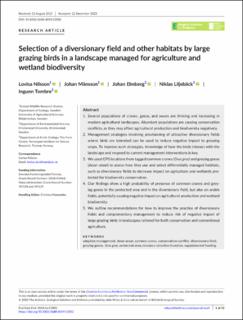| dc.contributor.author | Nilsson, Lovisa | |
| dc.contributor.author | Månsson, Johan | |
| dc.contributor.author | Elmberg, Johan | |
| dc.contributor.author | Liljebäck, Niklas | |
| dc.contributor.author | Tombre, Ingunn | |
| dc.date.accessioned | 2024-02-08T12:01:47Z | |
| dc.date.available | 2024-02-08T12:01:47Z | |
| dc.date.created | 2024-01-31T09:53:13Z | |
| dc.date.issued | 2024 | |
| dc.identifier.issn | 2688-8319 | |
| dc.identifier.uri | https://hdl.handle.net/11250/3116381 | |
| dc.description.abstract | 1. Several populations of cranes, geese, and swans are thriving and increasing in modern agricultural landscapes. Abundant populations are causing conservation conflicts, as they may affect agricultural production and biodiversity negatively. 2. Management strategies involving provisioning of attractive diversionary fields where birds are tolerated can be used to reduce negative impact to growing crops. To improve such strategies, knowledge of how the birds interact with the landscape and respond to current management interventions is key. 3. We used GPS locations from tagged common cranes (Grus grus) and greylag geese (Anser anser) to assess how they use and select differentially managed habitats, such as diversionary fields to decrease impact on agriculture and wetlands pro-tected for biodiversity conservation. 4. Our findings show a high probability of presence of common cranes and grey-lag geese in the protected area and in the diversionary field, but also on arable fields, potentially causing negative impact on agricultural production and wetland biodiversity. 5. We outline recommendations for how to improve the practice of diversionary fields and complementary management to reduce risk of negative impact of large grazing birds in landscapes tailored for both conservation and conventional agriculture. adaptive management, Anser anser, common crane, conservation conflict, diversionary field, greylag goose, Grus grus, protected area, resource selection function, supplemental feeding | en_US |
| dc.language.iso | eng | en_US |
| dc.rights | Navngivelse-Ikkekommersiell 4.0 Internasjonal | * |
| dc.rights.uri | http://creativecommons.org/licenses/by-nc/4.0/deed.no | * |
| dc.subject | adaptive management | en_US |
| dc.subject | Anser anser | en_US |
| dc.subject | common crane | en_US |
| dc.subject | conservation conflict | en_US |
| dc.subject | diversionary field | en_US |
| dc.subject | greylag goose | en_US |
| dc.subject | Grus grus | en_US |
| dc.subject | protected area | en_US |
| dc.subject | resource selection function | en_US |
| dc.subject | supplemental feeding | en_US |
| dc.title | Selection of a diversionary field and other habitats by large grazing birds in a landscape managed for agriculture and wetland biodiversity | en_US |
| dc.title.alternative | Selection of a diversionary field and other habitats by large grazing birds in a landscape managed for agriculture and wetland biodiversity | en_US |
| dc.type | Peer reviewed | en_US |
| dc.type | Journal article | en_US |
| dc.description.version | publishedVersion | en_US |
| dc.rights.holder | © 2024 The Authors | en_US |
| dc.subject.nsi | VDP::Zoologiske og botaniske fag: 480 | en_US |
| dc.subject.nsi | VDP::Zoology and botany: 480 | en_US |
| dc.source.volume | 5 | en_US |
| dc.source.journal | Ecological Solutions and Evidence | en_US |
| dc.identifier.doi | 10.1002/2688-8319.12302 | |
| dc.identifier.cristin | 2239331 | |
| dc.relation.project | Formas: 2018-00463 | en_US |
| dc.relation.project | Andre: Naturvårdsverket: 19/128 | en_US |
| dc.relation.project | Andre: Naturvårdsverket: 19/129 | en_US |
| dc.source.articlenumber | e12302. | en_US |
| cristin.ispublished | true | |
| cristin.fulltext | original | |
| cristin.qualitycode | 1 | |

